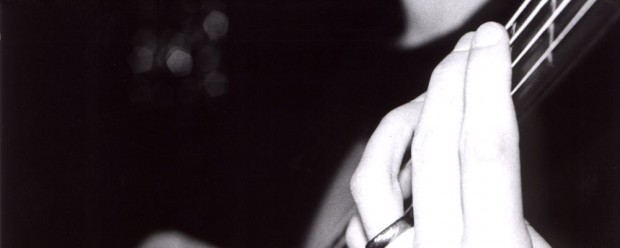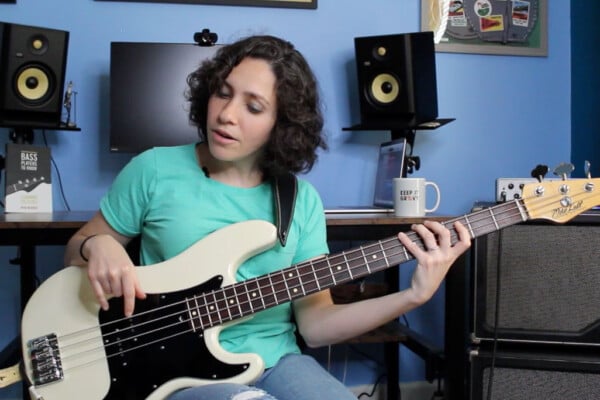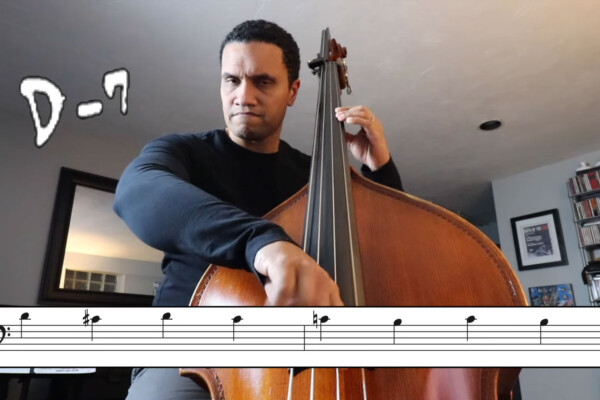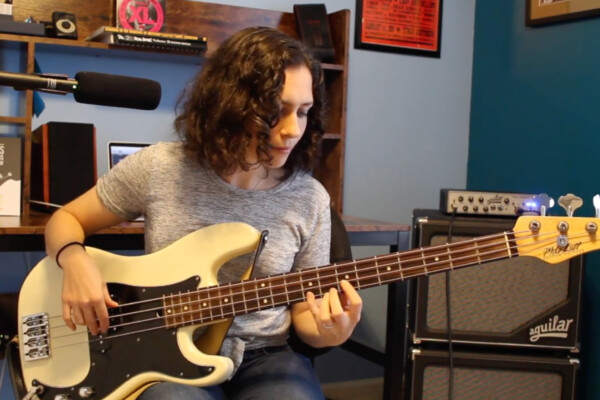Connecting Chords: A Guide to Playing Fluid Bass Lines

Q: I would like to ask about voicing/phrases on bass when it comes to chord progressions. How should I step into the next chord when I’m phrasing the actual one? Should I try walking lines? Are there any standard licks that can bring the feel of translating to a next chord? Or they are all built on the same concept (like chromatic approach)? I started to practice arpeggios and that’s useful because I’m getting a better knowledge of the fretboard and where the notes are. But I’m still missing the continuity. What do you suggest?
A: The way I understand your question is this: you would like to connect chords in a musical way, much like a guitarist or pianist would, and you would like to be comfortable using the entire fretboard to connect chords one and two musically.
Simply speaking, when working with chords (or melodies, licks or shapes) we can connect things in one of two ways:
- Diatonically
- Chromatically
So as you might play a scale which has notes that are only a step apart, regardless of the line you are playing, chords connect in much the same way.
For example, if you are playing arpeggios, the notes are always a 3rd apart, but there are notes in between each note of your arpeggio that you can make use of if you know what and where they are.
Diatonic means within the tonality that you are currently in. If you are playing in F major, only notes within F major are “diatonic”.
Chromatic is approaching anything by a half step (from any direction), regardless of key or tonality.
I would encourage you to explore both, and I’m going to speak mostly about diatonic relationships here.
Students often ask me how I’m connecting chords when I comp for them in a lesson. The answer is almost “diatonically”. Even if I change the inversion to make it step-wise, it likely is still diatonic to the key.
If we write down the C Major scale and then use the notes of that scale to arpeggiate from each note from within the scale, we basically get a chord built off of each note in the scale.
Review this page from one of my books (PDF download). This is a guide for the notes of each mode in the major scale. It also includes the chord types for each mode. In other words, if you stack each of these modes in 3rds, these are the chords that you will have created.
So, if you’re looking at a chart with a CMaj7 chord followed by a FMaj7 chord, you could walk chords up the neck from one to the other, playing the appropriate diatonic chords for C major:
C?7 D-7 E-7 (or Esus(?9) F?7
You can also use a walking bass line to create a connection between chord shapes.
Or you could hold one chord, play a walking bass line underneath and use a few of the appropriate diatonic chords to connect your changes.
There are almost as many ways to successfully connect chords as there are ways to voice chords.
If the chords are a whole-step apart, you might try connecting the chords by playing the 1st, sliding your bass note up one half-step and then shift to the 2nd shape. What works and what will not depends much on the musical context and setting as well as your ability to play it musically.
We have to be very careful when taking this type of stuff out of the shed and onto the stage. The role of the bassist never changes, no matter how much neat stuff we can do. You also have to be artful so you don’t clash with the chordal instruments. If there’s a pianist and a guitarist, chances are that you should leave this stuff in the shed.
But, it is a fantastic way to explore your instrument and various harmonic connections.
When you listen to a pianist, you will likely hear that super-hip, slippery, weaving-through-changes stuff being played with their left hand (the “bass” hand). So exploration of this stuff can certainly help you with regard to how you can connect chords together as a bassist. Very helpful explorations, indeed.
You also asked about voicings. Because of the sonic range of our instrument, we are limited by what will actually sound good where voicings are concerned. Inversions work nicely, especially with the 3rd in the bass. You are by no means limited to strict inversions, though – any note in the chord-scale can sound good in a line at the bottom of a chord. Like I said, it mostly depends on context and musicality. When we play anything other than the root, we are changing the way the chord is operating (the degree of change depends on what note we play and the harmonic context of the chord in the song).
There are really no rules or tricks to speak of. It’s really about trying to understand 1) your instrument 2) harmony 3) music in general 4) how they all interact and intersect.
You have to try a million things, grab a few that actually sound cool and explore why and how to build upon that. Resist temptation to try everything all the time when actually making music with people but go nuts in the shed and explore everything. Overturn every rock and see what’s underneath. When you find something that resonates with you, nurture it.
The melodic and the harmonic approach are really the same thing (in response to the last sentence of your question). The key is to listen hard while you play. If it sounds good, it is good.
Readers, how about you? How do you approach this in the shed and on the stage? Please share with us in the comments.
Have a question for Damian Erskine? Send it to [email protected]. Check out Damian’s instructional books, Right Hand Drive and The Improviser’s Path.




Try out diatonic shapes or themes, and try to lock them rhythmically with the drummer and/or the lead guitar or rhythm guitar/chord instrument in either contrary motion or according to what the others are playing.
I often use the approach of musical shape on a micro-level very deliberately in for instance 4 bar progressions: ABBA, AABA, AABC, ABCA etc.
I always try to come up with some rhythmic or melodic theme in my playing: some recurring notes, intervals or scalar patterns in concordance with what the others are playing both rhythmically and harmonically, that is somehow related to what the others are playing. If the others players are deliberately or un-wantingly ‘sloppy’ in terms of time, this can be a huge challenge. But a solid foundation will always make the other guys sound better, and that’s something to take pride in!
Hey Damian, I think you might have mis-linked the .pdf for your book. It just redirects me to this page instead of giving me a download. Maybe that’s just my computer though… Good article as always
Kool need to know stuff!
Last sentence of second to last paragraph. So on point.
“Modes of the Major Scale” does not compute.
The Major (Ionian) Scale is but one of the seven modes of the Diatonic Scale (*).
The fact that the other six modes can be derived by iteratively rotating the Major Scale is no less true if one starts from any of the other modes. Moreover, since three of those modes have major thirds, and three have minor thirds, they can hardly be thought of monolithically.
(*) The subset of Heptatonic Scales containing only tone (5) and semitone (2) intervals, whose semitone intervals are maximally separated.
I find helpfull to think harmony as a melody, even if Im playng just a few notes. It’s easier to conect chords.
best advice i’ve ever heard
Getting the right tone is 12%, getting the right rhythm is 37%, catching them both in a musical way is the other 51%
“Resist temptation to try everything all the time when actually making music with people but go nuts in the shed and explore everything.” …….great comment….This just adds to your knowledge. The more you know, the less you know….they key is playing the pocket and having choices based on the particular musical situation.
Miles used to say that “is about the notes you don’t play”.
It also helps to know what the bassist’s priorities are in ensemble work: 1. Ground the harmony. Basically, this means on the 1st beat of every measure play the root note of the chord for that measure, 2. make sure the back-beat happens with your interaction with the drummer. 3. Solo as required based on the melody line for the song, and, 4. Sing as required. To paraphrase Steve Gadd, All the flash and technique don’t mean shit if the bassist and drummer don’t make a groove and lock it in.
James Jamerson! He was the man. If you want to hear some great examples of everything you are wondering about, there you go. Studying his lines is imperative. A jazz bassist who reshaped the way popular music can be played.
Another thing is to consider studying some counterpoint. It might sound like a bit of task, but it used to be that basslines were sung by the lowest member of a group and still contained melodic content. Any great bass player understands some fundamental rules of it, even if they’ve internalized the sound. They should become a melody!
I think you have to see the Target Note (the Root of the new chord on the beat where this new chord starts) as the solution – the resolving of the thing you played before – the tension you created just before the new chord comes. So this “new target note” should have in some way the releasing energy of the thing you played before. As A bassplayer you can create some disbalance or attention to indicate the harmonies are moving on the next chord. So you are “the guide” and you “direct” everyone to that new chord. and the new target note – the root of the new chord – should be the solution of what you played before: Balance -Disbalance – Balance. Your riff should either have a clear direction to the new root (moving up or down from the actual one (like going from a “C” to a lower “G” or a higher “G”)) and have that G as a clear solution. Or you make a melodic approach in which again the new root is bringing back the balance. Chromatics work for this as you can first make a big step to indicate direction and then build tension by taking the half steps inbetween untill the new target note resolves. So think as movement in a direction or resolving a (more or less) logic riff on the new target note. Hope that helps you on the way.